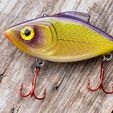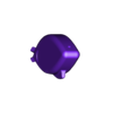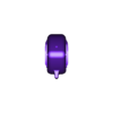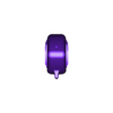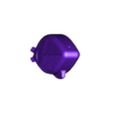a While back I realised my tackle box had very few lipless crankbaits in it. So I went out a purchased a few. Sadly most of them disappointed me: They all require at least a medium retrieve to achieve a half-decent action. Retrieve too slow and they just do nothing. Secondly, most lipless cranks sink like a ball of lead. So you need fairly deep water to sun them. This is not always a bad thing, but it was a limitation.
So I set out to design my own. My design goals were as follows:
- It should have strong WIGGLY action even at a very low speed.
- the design should allow for flexibility. If you want it to float, suspend or sink the design should accommodate them all while still being stable at speed. This is achieved by changing the volume of weight.
- It should print as a single-piece lure with no assembly.
After many design iterations, I managed to achieve all of the above goals successfully. As this lure is now much more versatile than a standard lipless crank, I have dubbed it the Swiss Army Rattler: It will do it all! It will even wiggle in the fall if you make a normal fast sinking version! Due to the strong action, this lure gets very loud. I guarantee this lure will outperform any other lipless crank of the same size with regard to action and usability, I am that confident in it. It will catch a lot of fish!
This is is original and 65 mm version of the above design. Please note there are 4 versions of the lure included depending on the look you want. One is just a plain blank canvas. One has raised gill plates, a third has just a scale pattern and the last has both a scale pattern and raised gill plates. All versions have a recess for 8mm eyes.
Prints as a single piece with internal rattles and weights. The front hook eye and tie-on eye are single through-wire, so it is very robust. It will easily suspend 15kg of weight for any amount of time. The design allows for changing the sound of the rattle depending on the weights used. Easily make high pitched rattle with 4.5mm BBs or a low-pitched "2 tap" version using 8 and 8mm steel bearings. The only important part when it comes to retaining stability in swimming actions is that the front chamber should always be heavier than the rear chamber. If it is not the lure might become unstable at high speed. I have tested even 50/50 weight distributions and it works fine at slow and medium speeds, but might become unstable at high speeds, depending on the hooks used. Feel free to experiment, though!
Weighting suggestions:
Floating
3-4 x 4.5mm BBs in the front chamber
1-2 x 4.5mm BBs in the rear chamber
Slow sinking
4-6 x 4.5mm BBs in the front chamber
2-4 x 4.5mm BBs in the rear chamber
Fast Sinking
6-8 x 4.5mm BBs in the front chamber
4-5 x 4.5mm BBs in the rear chamber
A detailed step-by-step guide on how to build this lure will be available very soon.
Please be aware that these files are for non-commercial use only. Print one or print a million, it's up to you. You are welcome to hand them out to friends and fellow anglers. Your friend wants one but doesn't have a printer? Print it for them and have them reimburse you for the cost of the material. No problem.
Please respect the fact that a lot of time and effort went into making these designs and associated media. You may not under any circumstances resell the design (file) or the resultant lure made from the print at profit.
Please respect the fact that a lot of time and effort went into making these designs. You may not under any circumstances resell the design (file) or the resultant lure made from the print at profit.

/https://fbi.cults3d.com/uploaders/19766919/illustration-file/85e55ce6-f94f-4830-85dd-8ae431b4e3f4/Consumable-stock-2900.jpg)
